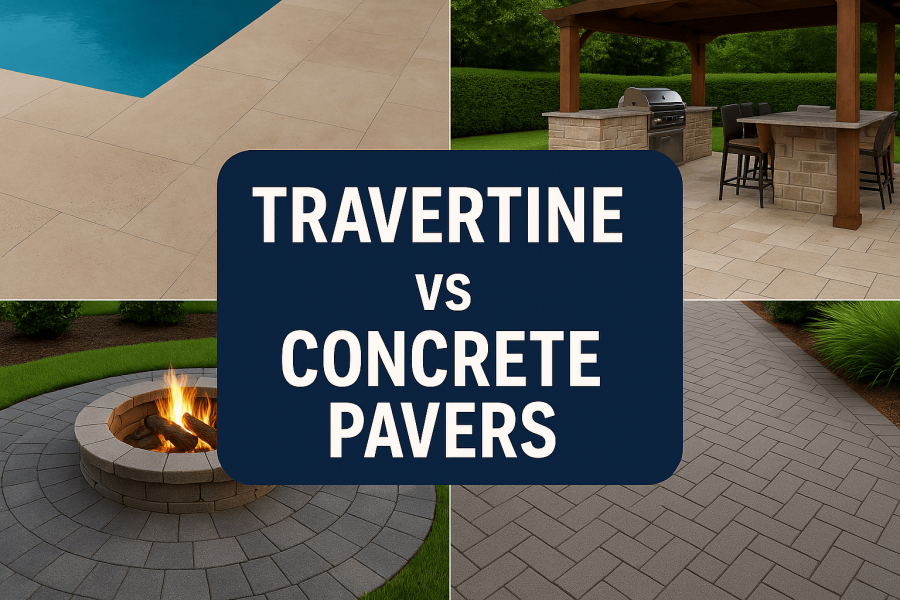- >
Bermuda Sod
- By: Nicholas Indellicati
- Date: Oct 23 2020
Similar Articles
Artificial Turf vs Sod for Lawns, Backyards & DIY Makeovers
Thinking about artificial turf or sod? Discover the pros and cons of each—from cost and maintenance to durability and pet-friendliness—so you can choose the best option for your lawn or backyard project.
Travertine vs Concrete Pavers for Florida Pool Decks, Patios, Fire Pits & More | bhild
Compare travertine and concrete pavers for Florida pool decks, patios, and driveways — from heat retention and slip resistance to cost, maintenance, and curb appeal.
Beat the Heat: Florida Summer Landscape Survival Guide
Beat the Florida heat with smart summer landscaping. From drought‑tolerant plants to shaded retreats, this guide covers designs, materials, and maintenance tips to keep your yard thriving all season long.
On This Page:
- What is Bermuda Sod?
- The History of Bermuda Sod
- Types of Bermuda Sod
- Bermuda Sod Application
- Pros & Cons of a Bermuda grass
- Pros of Bermuda sod
- Cons of Bermuda sod
- Features of Bermuda Sod
- How to Care for Bermuda Sod?
- The pH level of Bermuda Sod
- How does Bermuda feel?
- What length should you cut St. Augustine?
- Hard-wearing Bermuda Sods
- Cost Comparison
- The Conclusion
All about Bermuda Sod
Are you about to plan to do a sodding in your yard in the coming days? If yes, you would likely be looking for a suitable sod. But, have you thought of the one you are going to select? Thus, there are different types of sods out there. So, choosing the most suitable is challenging. Therefore, Bermuda Sod is an appropriate sod for your yard.
Without pointing out the difference between the kinds of sods. Can turn your sodding into a terrible one. If you wish to know about Bermuda, don’t get tens. However, as we are offering you a complete information guide. Moreover, side-by-side comparison of Bermuda sod. So, without any further doing late, let’s get going.



What is Bermuda Sod?
Bermuda Sod is originated mainly out of cross-breed sod or sometimes from improved ordinary varieties. However, these grasses are cut-outs of Bermuda Sod beds. Yet, where grass along with a surface of soil below is held together by the root mechanism. The hybrid Bermuda sods do not produce seed. Thus, they produce by an involuntary process like sod.
The cross-breeds have a very smooth surface. Moreover, these grasses are more costly than ordinary kinds such as Sahara. Thus, Bermuda sod needs more protection and conservation for growing and expanding.
Moreover, Bermuda provides almost rapid covering with green sod. It can take only 14 to 21 days to generate an average lawn fully. Furthermore, sods come in the form of rolls (of 10 square feet size each), bedsteads (i.e., stockpile covering 450 square feet each), or even portions (3 square feet each). Thus, the Bermuda grass rapidly takes root in the yard to produce thick and rich green coverage.
The History of Bermuda Sod
Like almost all sod kinds, Bermuda sod is an established plant in the United States of America. Indeed, the inception of the first origination of Bermuda most likely came from polluted straw. It was utilized as bedding when slaves brought to the US. Many and many of the seeds were dispersed at the start over the eastern US. Thus, living greenery then was able to produce more seeds and so forth.
Bermuda plants were then utilized solely for fodder causes for a couple of years. Moreover, no doubt is also a yard grass by default, even though the seed traded mostly for fodder. Furthermore, Bermuda was utilized in the southern US in the early 1900s as a golf course grass. It was also utilized as an “alternative” for sand greens, precisely that – a putting layer comprised of sand, with no grass. Thus, over many decades, lower growing kinds of “common Bermuda sod” started to appear on seeded Bermuda sod greens. However, it is not for home yard usage because it needs low trimming heights of ½” or less.
Types of Bermuda Sod
Out of the upgraded common varieties of Bermuda sod, Ormond and Tifdwarf often utilized as Bermuda grass. However, cross-breeds are the best for grasses.
Here are some of the cross-breed sorts used in Bermuda grass.
Tifway Bermuda (T-419) is an excellent sod. The shade of the sod is dark green with medium smooth surface leaves. Moreover, it is a rich sod with a medium to low expanding rate. Thus, the expanding rate of this kind is rapid. Subsequently, it expands best in hot weather when soil pH is between 6.5 and 7.2.
It remains inactive after trimming. It is a dearth lenient. Furthermore, with proper care, it can also recuperate from pest injury. It’s usually cultivated as branches or as grass. Hence, this variety is generally utilize on golf course land sites and tees, playgrounds, and countrysides.
Other cross-breeds generally used as Bermuda grass include Tifgreen, Tifgreen-II, Tiflawn, Floratex, and such. There are a lot more varieties of cross-breed kinds that are also utilize as Bermuda grass. Thus, you should check with your local sod retailer and find out the best match for your soil kind.
Bermuda Sod Application
Put a quarter to a half-inch of water the night before applying sod. So, the soil should be wet when you began applying it. But it should not be grubby. Further, begin applying the sod portions end-to-end starting along the most extended straight corner of the area. Thus, make sure that each Bermuda sod piece is tightly placed next to each other.
Pros & Cons of a Bermuda grass
The kind of grass you select will affect your yard’s ornamental and conservation requirements, so it’s essential to consider the positive and negative points before making your selection.
Pros of Bermuda sod
- Heat and dearth lenient – This warm-weather sod can bear harsh situations, including hot temperatures and scarcity. Even though it needs at least a weekly watering to remain nourished.
- Firm – Bermuda sod is firm. However, sufficient to suffer high traffic and doesn’t wear easily.
- Easy to expand – Moreover, in the mild weather and light situations, Bermuda sod care is made more accessible by its desire to expand.
Cons of Bermuda sod
- Inflexible to winter – It only takes some days of winter climate to turn this rich green grass into a faded, straw-like texture.
- Fierce – The similar feature that makes it easy to expand can make it hard to contain. Thus, the additional work may be needed to keep Bermuda sod from extending to undesired areas. Such as garden beds or adjacent properties.
- Shade inflexibility – Needing a minimum of six hours of sun. Thus, development can become thin and limited in parts with little or no sunlight, such as under trees or close accessibility to towering buildings.
Features of Bermuda Sod
There are several differences in their features when you contrast Bermuda Sod with other sorts of grass sods.
- One of the significant characteristics of Bermuda Sod is its traffic sufferance, which is the highest amongst all kinds of sods.
- However, when it comes to insect and pest impedance. Bermuda sod has exceptional insect and pest impedance.
- Bermuda Sod has smooth blades.
- Bermuda grass is seasonally drowsing (in the cold).
- Bermuda sod has the fastest growing rate of any of the warm-season sods.
- Moreover, it spreads by both stems. They are above-ground stems known as stolons and below-ground stems called rhizomes.
- It recovers from injury far more rapidly than most grasses.
- Bermuda grass is appropriate for southern yards from coast to coast.
- It is heat, drought, traffic, and salt sufferance.
How to Care for Bermuda Sod?
Consider these points for Bermuda Sod maintenance:
Trim
- Retain a height of between one-half to two-and-a-half inches
- Start trimming in the spring when the sod turns green.
- Cut regularly enough that no more than one-third of the blade cut at a time.
- Always use an intense blade
- Avoid bagging unless fleece for the first spring trim
Water
- Water only as required
- Water enormously once a week, drenching the soil to a depth of about six inches
Fertilize
- Add one half to one pound of nitrogen fertilizer per every thousand square feet of sod or whatever ratio the label guides
Oxygenize
- Oxygenize at the start of summer, before fertilizer addition
Insect Control for Bermuda sod
- Add pre-arising insecticides for spring and summer insects after the warning of winter damage
- Broad-leaf insects may be administered with post-arising additions and always follow label guidelines
- Do not maximize more than two to three doses of insecticide per annum
The pH level of Bermuda Sod
Bermuda sod grows better when soil pH is between 5.8 and 7.0. But it will suffer more alkaline situations. However, in areas with overly acidic soil, regular lime additions may be required to maintain pH at normal levels for nutrient availability.
How does Bermuda feel?
Bermuda Grass Has Barbs on their Leaf. Old Bermuda grass was scratchy due to microscopic barbs that ran along the edges of the leaf of this grass type. However, these barbs are not visible to the naked eye. They were there all along. Furthermore, it would irritate the skin of children who played on these old-style Bermuda grass lawns.
When we look at these Bermuda grass leaf barbs under a microscope. We can see they look like sharp little hooks and spikes running along the edge of the leaf. But, when we see them this way, they do look kind of mean!
So, these microscopic barbs on the Bermuda leaf were responsible for the old Bermuda grass being so scratchy and irritating.
Why Is New Bermuda Grass Soft
Nowadays, there are many different kinds of soft Bermuda grasses for sale. Thus, most of these new soft Bermuda grasses are genuinely and equally delicate. With no irritation factor.
So what makes these new Bermuda grasses soft?
Only the presence of barbs made old Bermuda grass scratchy. Thus, the reduction of and change in the shape of these same barbs on leaf result in soft Bermuda sod.
What length should you cut St. Augustine?
Bermuda sod is generally trim at 0.5 to 2.5 inches. However, cross-breed Bermudagrass cultivars are shorten at heights from 0.5 to 1.5 inches. Generally, Bermuda sod should cut at 1.5 to 2.5 inches. Thus, higher cutting heights may be required on irregular yards to keep away from overcharge.
Hard-wearing Bermuda Sods:
Yet, we have added nutrients to the Bermuda turf in the form of fertilizers. So, we have stopped using the area for any wear and tear during the repair phase. Thus, we have ensured the yard is getting appropriately watered. Moreover, it receives the most benefit from that watering by applying wetting agents and sprayed for any heavy weed infestations.
Within a few weeks, one can see some improvements to our Bermuda lawn. Next, it’s time to adjust our lawn mowing practices.
Cost Comparison
A lot of people are installing sod instead of grass. It is because of cutting down on maintenance and ongoing expenses. Fortunately, there are numerous kinds of sod to choose from them. All have their advantages and disadvantages. Thus, as most remodeling projects do, the selection will largely depend on cost. Luckily, we have researched the average Bermuda costs below:
| Type of Sod | Low Cost Per Square Foot | High Cost Per Square Foot |
| St. Augustine | $0.30 | $0.67 |
| Bermuda | $0.35 | $0.75 |
| Fescue | $0.33 | $0.66 |
| Zoysia | $0.42 | $0.69 |
If you want to arrive at the total cost of sodding your yard area, you must first measure your lawn’s total square feet area. Then multiply that with the value. However, if your yard area is not exactly square or rectangular and has an irregular shape. An excellent method to go about this is to specify the primary size that’s identified as rectangular. Thus, then divide the remaining rough areas into smaller triangles and rectangles or even circles.
- Size of a square or rectangle = Length X Width
- Area of a triangle = (Height X Base) / 2
- Size of a circle = 3.14 X Radius X Radius
The Conclusion:
Summing up, there’s no reason to delay your Bermuda sod project any longer.
When your plans call for a tough, durable, and wear-resistant warm-season lawn that withstands heat and drought, the grass is the perfect solution. Materials are flexible. Yet, installation and nurture times are low.
While some self-built, others like the peace of mind. That comes with hiring professionals.
In the end, we are hopeful that our take on a side-by-side guide regarding a Bermuda sod would help you in choosing the one that suits your priorities.








